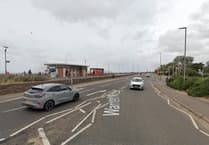SUE LLOYD, local historian and author, traces a way of life that is fast becoming little more than a memory ...
Minehead fish weirs were for centuries an important part of making a living from the sea, but the fishing families of Quay Town had other ingenious ways of catching fish in the old days without needing to venture out in a boat.
For instance, ‘kettle nets’ used the same principle as weirs. About five to six feet high, they were used in pairs to form a V-shape on the beach. The nets were tied to elmwood poles and Quay Town residents now in their sixties and seventies remember being helped by their grandfather or dad to set them up.
When weirs were still in use, John Slade had fastened a kettle net outside the walls of his fish weir. In July 1921 he found 1,000 mackerel in his kettle nets! Such a haul had not been known for 16 years, according to a report in the Free Press.
Visitors were still noticing, a week later, a luminous fringe to the waves, which may have been due to the large number of mackerel in the channel.
In recent years, herrings have returned to the Bristol Channel and Minehead fishermen have recorded good catches but nothing compared with the distant days when ‘herring trains’ left Minehead, Ilfracombe and Barnstaple with boxes of up to 200,000 prime fish aboard, bound for London and the Continent.
Another way of trapping fish as the tide went out was to lay 60-yard-long lines seaward in grooves in the pebbles, baited with worms or sprats to catch cod. Each line might have 20 or more hooks. This method, like the kettle nets, was used well into the 1950s, until the fish stopped coming.
Traditionally, each Quay Town family had its own line or lines, set about six feet apart along the length of the beach.
Catching fish this way was not easy, especially during the winter, when fingers quickly froze detaching fish from the line. Bending low to twist the fish off the hooks was awkward for adults, so children had to help out, missing school if necessary, as the lines had to be cleared quickly at low tide, day or night.
Of course, you would only take fish from your own family’s line. The non-local fiancé of a Quay Town daughter caused havoc by helpfully stripping the fish off a neighbour’s line, the next one along. To make matters worse, the visitor had not carefully removed the fish from the hook, but simply cut the fish, and hook, away! Relations with the neighbours must have been strained for a while.
One former method of catching fish without going to sea is still used. Local fishermen Michael Martin and Paul Date own a net stretched on poles on the beach. The S-shaped line of poles near the Quay Inn has always belonged to the Martin family.
Every winter during the herring season, the two men stretch a net along the poles. As the tide goes out, the herrings, the ’silver darlings’ as they are called in Quay Town, are left behind, stuck in the netting.
A variety of fish can still be caught off Minehead, either from a boat or from the harbour wall. Huge rays caught by Captain Thomas Rawle used to be pinned up for sale, on the outside passage wall at his house at 11a Quay Street, frightening any visiting grandchildren.
At the turn of the century, John Stone Webber Slade caught a shark taller than himself. This was such a notable event that a photograph was taken to mark the occasion.
More article in the week’s Free Press (October 8). Many thanks to many Quay Town residents for contributing memories and photographs.




